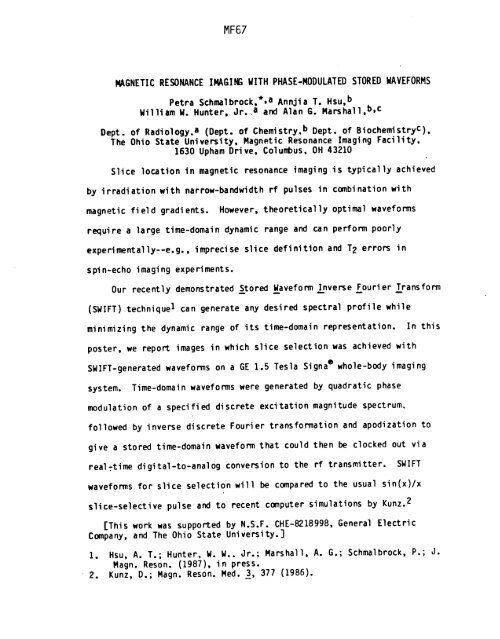th - 1987 - 51st ENC Conference
th - 1987 - 51st ENC Conference
th - 1987 - 51st ENC Conference
Create successful ePaper yourself
Turn your PDF publications into a flip-book with our unique Google optimized e-Paper software.
MF67<br />
MAGNETIC RESONANCE IMAGING WITH PHASE-MODULATED STORED WAVEFORMS<br />
Petra Schmalbrock, *,a Annjia T. Hsu, b<br />
William W. Hunter, Jr. a and Alan G. Marshall, b,c<br />
Dept. of Radiology, a (Dept. of Chemistry, b Dept. of BiochemistryC),<br />
The Ohio State University, Magnetic Resonance Imaging Facility,<br />
1630 Upham Drive, Columbus, OH 43210<br />
Slice location in magnetic resonance imaging is typically achieved<br />
by irradiation wi<strong>th</strong> narrow-bandwid<strong>th</strong> rf pulses in combination wi<strong>th</strong><br />
magnetic field gradients. However, <strong>th</strong>eoretically optimal waveforms<br />
require a large time-domain dynamic range and can perform poorly<br />
experimentally--e.g., impreci se slice definition and T 2 errors in<br />
spin-echo imaging experiments.<br />
Our recently demonstrated Stored W_aveform Inverse F_ourier T_ransform<br />
(SWIFT) technique I can generate any desired spectral profile while<br />
minimizing <strong>th</strong>e dynamic range of its time-domain representation. In <strong>th</strong>is<br />
poster, we report images in which slice selection was achieved wi<strong>th</strong><br />
SWIFT-generated waveforms on a GE 1.5 Tesla Signa ® whole-body imaging<br />
system. Time-domain waveforms were generated by quadratic phase<br />
modulation of a specified discrete excitation magnitude spectrum.<br />
followed by inverse discrete Fourier transformation and apodization to<br />
give a stored time-domain waveform <strong>th</strong>at could <strong>th</strong>en be clocked out via<br />
real-time digital-to-analog conversion to <strong>th</strong>e rf transmitter. SWIFT<br />
waveforms for slice selection will be compared to <strong>th</strong>e usual sin(x)/x<br />
slice-selective pulse and to recent computer simulations by Kunz. 2<br />
[This work was supported by N.S.F. CHE-8218998, General Electric<br />
Company, and The Ohio State University.]<br />
1. Hsu, A. T.; Hunter, W. W.. Jr.; Marshall, A. G.; Schmalbrock, P.; J.<br />
Magn. Reson. (<strong>1987</strong>), in press.<br />
2. Kunz, D.; Magn. Reson. Med._3, 377 (1986).













